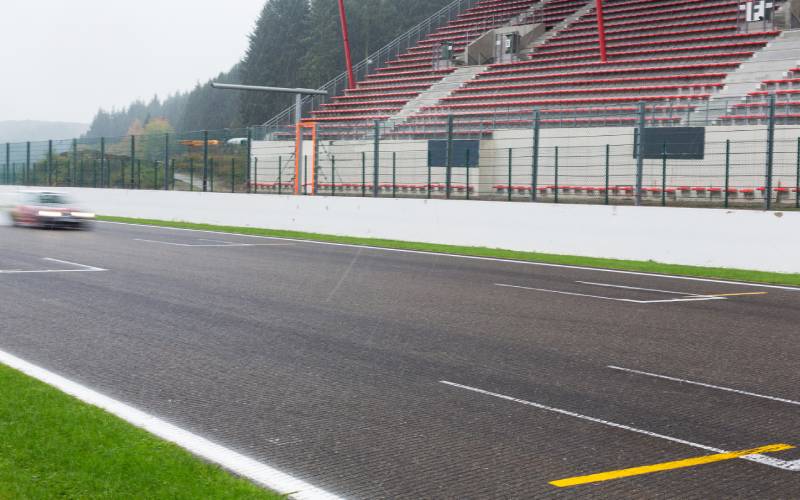How Weather Conditions Impact Race-Car Performance

Racing is an exciting sport that requires a lot of hard work and attention to detail. Unfortunately, plans can change when dark clouds loom overhead, and you start seeing rain droplets on the track. Rain and other weather conditions can change the race, and an experienced driver should know how to work around sudden changes.
Driven Racing Oil understands the importance of staying safe during a big race. Today, we’re looking at how weather conditions impact race-car performance. Knowing what to do in inclement weather can mean the difference between victory and defeat, so let’s get started!
The Role of Temperature in Tire Behavior
Temperature directly impacts the performance of race-car tires. Manufacturers create tires to operate within specific temperature ranges. When track temperatures rise, tires heat up faster, potentially becoming too soft. In other words, a hotter day may result in reduced grip and increased wear on your tires, affecting lap times and race strategy.
Conversely, cooler temperatures cause tires to harden, also limiting their grip on the track. Drivers must warm tires up during such conditions, or they risk reduced cornering speed and traction. Pre-race warm-up laps and tire blankets bring tires closer to their optimal temperature range for better performance during initial laps.
Air Density and Engine Performance
Several things affect air density, such as temperature, altitude, and humidity. These factors play major roles in engine performance, too. Colder air is denser and contains more oxygen, making it ideal for producing more power. This is because engines process air and fuel to create combustion; the higher oxygen content in cooler air allows for better combustion, boosting performance.
Naturally, hot and humid conditions decrease air density. With less oxygen available, engines must adjust their fuel-to-air ratios to ensure proper combustion. The change in oxygen can reduce your power output, requiring racers to tweak their engines to accommodate these changes.

Impact of Rain on Traction and Handling
Rain is what most people think of when discussing inclement weather, and it can definitely turn the tide of any race. Rain significantly reduces the grip between tires and track surfaces, making traction a critical concern. Standard racing tires, often referred to as slicks, are unsuitable for wet conditions as they provide minimal grip on slippery surfaces. When racers know they will be driving in wet conditions, they often use specialized wet-weather tires with deeper treads to help channel water and maintain contact with the track.
Drivers must also adapt their approach, braking earlier and accelerating more gently to avoid losing control. Reduced visibility from water spray demands heightened concentration and precise maneuvers to maintain competitiveness.
Wind Speed and Aerodynamics
Wind is another weather condition that impacts race-car performance. Headwinds create resistance, forcing the engine to work harder to maintain top speeds. While this may slow the car down slightly on straight sections, it can also improve downforce, providing more stability during cornering.
Tailwinds, on the other hand, reduce resistance and increase straight-line speed. However, decreased downforce means less grip around corners, posing additional challenges for drivers. Sidewinds are particularly tricky, as they can destabilize the car and require constant adjustments to maintain balance. Racers often tweak wing angles to maximize aerodynamic efficiency based on the forecasted wind conditions.
Track Conditions and Temperature Fluctuations
Track surface temperature fluctuates significantly depending on the weather and is a factor in determining tire grip levels. Sunlight can heat the track, creating ideal conditions for certain tire compounds. Cloud cover or cooler hours of the day may quickly lower track temperatures, leaving drivers struggling for traction.
Racetracks can also retain water in low-lying areas after rainfall, creating inconsistent surfaces. Puddles and damp patches must be navigated carefully, as they can cause hydroplaning or sudden loss of control. A thorough understanding of these track conditions and prompt radio communication between drivers and pit crews is essential in adapting strategies mid-race.

The Role of Humidity in Peak Engine Output
Humidity is another factor that influences engine behavior. High levels of moisture in the air reduce the oxygen available for combustion, impacting overall engine output. Race engineers must carefully monitor humidity levels to adjust fuel mixtures and maintain engine efficiency. Lower humidity levels allow for better air density, improving combustion and performance.
Humidity’s effect extends beyond the engine, as it can also impact tire pressures. Moisture trapped within tires can expand unpredictably as temperatures rise, making accurate pressure monitoring a critical task for race teams.
Fog and Visibility Challenges
Foggy conditions limit visibility for drivers. Reduced sightlines make it difficult for them to anticipate upcoming turns, obstacles, or braking points. Racers may also have a harder time seeing corner judges or trackside signals, increasing the risk of errors during a race.
Teams depend heavily on clear communication through radio systems in the fog. Spotters provide crucial updates on other drivers’ positions, helping drivers maneuver confidently within limited visibility. Precision and teamwork are vital for navigating these challenging conditions.
Seasonal Conditions and Race Strategy
Different seasons bring unique challenges to motorsport events. Summer races often feature high temperatures requiring aggressive tire management and careful monitoring of cooling systems to prevent overheating. Winter or autumn races may experience rain or early sunsets, which make tire selection and visibility important factors.
Teams often reflect on historical weather patterns to adapt their strategies. Detailed simulations and weather forecasting tools help them to stay ahead of shifting conditions, ensuring informed decisions on race day.
Fine-Tuning the Balance Between Machine and Nature
The racetrack is an arena where precision engineering meets the unpredictable forces of nature. While racing teams strive for perfection in their machines, understanding and adapting to weather conditions often separates the good from the great.
By mastering the balance between the car’s mechanics and external weather factors, teams can gain a tactical edge that leads to success on the track. This dynamic aspect of motorsports remains a testament to the skill, innovation, and resilience that define the pursuit of speed.
For those pushing their limits on the track, choosing the right oil is critical. Driven Racing Oil’s advanced formulas, including our specialized drag race oil, work to deliver maximum performance and protection under extreme conditions. Elevate your racing game—trust Driven Racing Oil to keep your engine running strong when it matters most.

You must login to post comments.